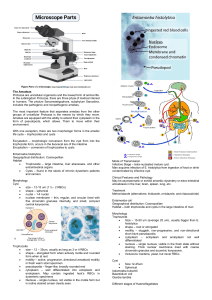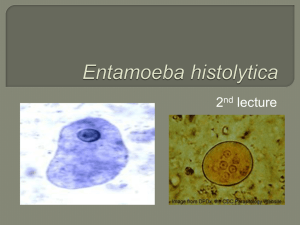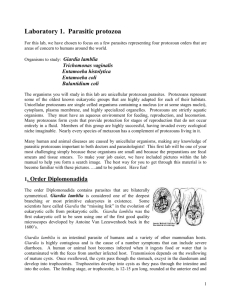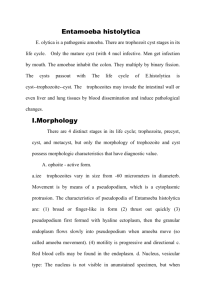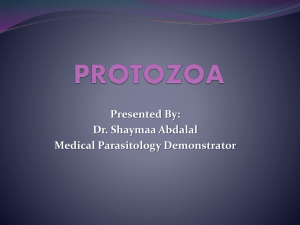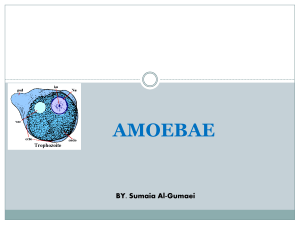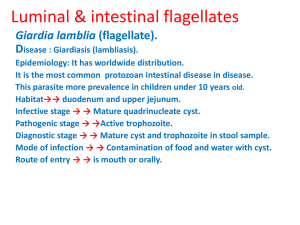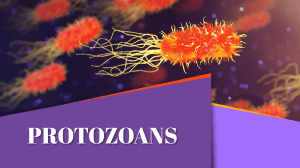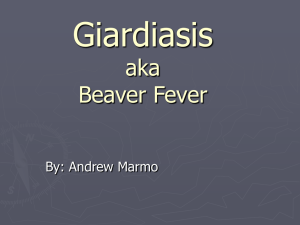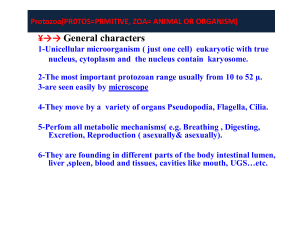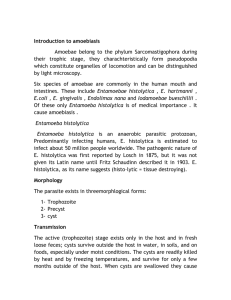Slide 1
advertisement
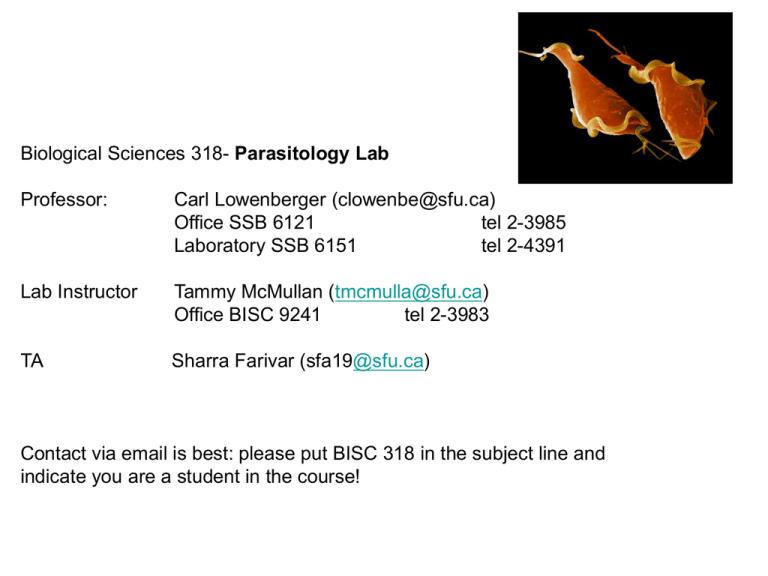
Biological Sciences 318- Parasitology Lab Professor: Carl Lowenberger (clowenbe@sfu.ca) Office SSB 6121 tel 2-3985 Laboratory SSB 6151 tel 2-4391 Lab Instructor Tammy McMullan (tmcmulla@sfu.ca) Office BISC 9241 tel 2-3983 TA Sharra Farivar (sfa19@sfu.ca) Contact via email is best: please put BISC 318 in the subject line and indicate you are a student in the course! Organization Handout Materials: Lab handout materials will be posted on Sunday/Monday before each lab. YOU should print it out and bring it to the lab. Lab book! Keep your notes for review, for exam preparation, for the future, or just to get a good mark. Follow standard procedure for lab notes. Time schedule ONLINE LAB 1: Parasitic Protozoa - Different stations with slides - Only 1 slide per person at a time. - Don´t break your slides!!!!! - All organisms of today´s lab will be studied under oil immersion. - Clean your slides with glass cleaner after using them! - Don´t give up! It is difficult to recognize and identify today´s samples. Lab Evaluation Grading: Lab exam 1 Lab exam 2 Participation: class and lab Group Presentation 10% 10% 5% 10% Total 35% Group Presentation Each lab will contain 24 students. We will break you up into groups of 4. Each group will choose a parasitic disease not covered in the course. The group will present a 20-30 minute presentation on the problems associated with this parasite and disease and based on this course, other courses, and readings, propose what might be done differently from current strategies to reduce/eliminate problems and suffering from with this parasite. Presentations will be made in the lab sessions in the week of March 24 (subject to change). Protozoan Parasites What are Protozoa – Protista? • Single-celled eukaryotes • Some have >1 nucleus during all or part of their life cycles • ~ 5 - 250 µm Largely recognized after the development of microscopes van Leeuwenhoek described all sorts of protozoa • many form cysts (protection) • invaded every ecological niche imaginable • nearly every species of metazoan has a complement of protists living in it Protozoa represent a unique type of evolution Organelles are cellular elaborations performing the same functions as tissue and organs in “higher organisms“ • Locomotion and feeding: cilia, flagella, pseudopodia • Osmoregulation: pulsatory vesicle, contractile vacuole • Infraciliature: coordinating system of cilia • Rhoptries: penetration of cells (Apicomplexa) • Cell covered in 3-layered Plasma membrane Giardia lamblia Kingdom I Archetista (Archezoa) Phylum Metamonada Order Diplomonadida Amitochondriate flagellated protozoan Bilaterally symmetrical Most primitive eukaryotes in existence Organism and Disease Associations Giardia lamblia, Giardia duodenalis, Giardia intestinalis Giardiosis (back-packers diarrhea), beaver fever (but no fever) Hosts and Host Range Humans, dog, cats, beaver (reservoir), coyote, cattle Geographic Distribution and Importance Cosmopolitan Most commonly reported human intestinal parasitic infection Sporadic individual infections / epidemic form (drinking water) Morphology Trophozoite (motile, active feeding stage; vegetative stage) BB N is pear shaped, 10-20 µm long, 7-10 µm diameter AD 8 flagella MB A PF Binucleate - both nuclei are transcriptionally active 2 rigid median bodies No mitochondria, peroxisomes, hydrogenosomes or other subcellular organelles for energy metabolism Anterior region contains structure for attachment to epithelial cells Structure is maintained with tubulin and giardins (calcium binding annexins) Surface is covered with cysteine-rich molecules Cysts (protective, infective stage) N A F ellipsoid excyst in response to physiological / environmental stimuli Following a series of stimuli: acid, pancreatic enzymes CW Motile parasite divides into 2 binucleate parasites Morphology Slide: Giardia lamblia trophozoite: This parasite is generally teardrop shaped with two visible nuclei. If you use the fine focus knob to focus in and out on the parasite you will be able to see the bi-lobed adhesive disc (smiley face). BB N AD MB A PF Theory N A F CW Practice Slide: Giardia lamblia cyst: Giardia cysts are slightly smaller than trophozoites and have 4 visibly distinct nuclei. A median rod, known as an axostyles, is often visible down the centre of the organism. Life cycle direct 1. Cyst 2. Cyst ingested, swallowed 3. Excysts in duodenum, trophozoites attach to epithelial cells in small intestine 4. Division: Binary fission 5. Form cysts feces Pathogenesis Tissue: small intestine Nausea, Diarrhea (> 7 days), weight loss, Steatorrhea, Malabsorption Diagnosis ELISA Microscopic examination of stool trophozoite cysts Trichomonas vaginalis Kingdom II Euprotista Phylum Parabasalia Order Trichomonadida Nearly all parasitic Small flagellates Only exist as trophozoites Organism and Disease Associations Trichomonas vaginalis Trichomonad vaginitis or Trichomoniasis in women Hosts and Host Range Humans (men & women) Geographic Distribution and Importance Cosmopolitan Prevalence of infection of 10 – 25% among women Estimated 7.4 million new cases occur each year in women and men (CDC) Men asymptomatic Morphology Oval and flagellated Basal body Nucleus Undulating membrane Axostyle Terminal flagellum Karyomastigont apparatus: • anterior tuft of flagella • axostyle • parabasal body (equivalent of GA) • costa • costal granules (hydrogenosomes energy metabolism) • nucleus Life cycle 1. Trophozoite 2. Binary fission 3. Direct transmission through sexual intercourse (no cyst stage) Pathogenesis Remain and multiply in vagina and cause inflammation of the epithelium. excessive production of mucus; pain. Can invade other organs such as kidney Diagnosis Microscopic examination vaginal swab, urethal swabs Entamoeba histolytica Entamoeba coli Kingdom II Euprotista Phylum Rhizopoda Order Entamoebidae Amoeba: organism that moves and feeds with pseudopodia. Parasites (E. histolytica) or commensals (bulk; E. coli) of digestive system. Organism and Disease Associations Entamoeba histolytica Amoebiasis, amoebic dysentery Hosts and Host Range Mainly humans But: higher primates, dogs, cats and some rodents Geographic Distribution and Importance Cosmopolitan 50 million cases of invasive amoebiasis annually 50000 – 100000 deaths 3rd most common cause of parasitic death in the world Morphology Slide: Entamoeba histolytica trophozoite: Trophozoites are round with large lobular pseudopodia and a clock-face nucleus. The nuclear endosome is typically (but not always) centrally located. You may see erythrocytesin in the cytoplasm, indicating digestion of erythrocytes. GE E N En P Theory 4N En Practice Slide: Entamoeba histolytica cyst: Cysts are smaller than trophozoites. They contain 4 nuclei and chromatoid bars (tightly packed messenger RNA with rounded ends). Morphology Species 2: Entamoeba coli: Another species that occurs in the intestine of humans. It is a harmless commensal of the human large intestine, but looks similar to Entamoeba histolytica. Therefore it is important to be able to distinguish between these two forms. Slide: Entamoeba coli trophozoite: distinguished from E. histolytica by its coarser chromatin, eccentrically located endosome and the absence of erythrocytes in the cytoplasm. N En Theory 8N Practice Slide: Entamoeba coli cyst: E. coli cysts contain 8 nuclei (compared to 4 nuclei seen in E. histolytica) and smaller chromatid bodies that are often filamentous. Life cycle 1. Cysts and trophozoite in feces 2. Direct transmission; Ingestion of mature cysts 3. Excystation in small instestine 4. & 5 Tetranucleate amoeba divides into four amoebas which are carried to the large intestine. Pathogenesis Tissue: large intestine (colon, cecum) Amoebic dysentery, erosion of mucosa and coating of the epithelium in the intestine, invasion of tissue causing flask-shaped ulcer can reach the bloodstream can finally result in peritonitis (bacteria reach abdominal cavity) Diagnosis Microscopic examination of stool Balantidium coli Kingdom II Euprotista Phylum Ciliophora Family Balantidiidae Largest protozoan parasite of humans Heterokaryotic (i.e. two kinds of nuclei) Conjugation (temporary union of individuals and interchange of genetic material) Only member of its phylum known to be pathogenic to humans Organism and Disease Associations Balantidium coli Balantidiosis and balantidial dysentery Hosts and Host Range Humans, other primates, swine Geographic Distribution and Importance Cosmopolitan Balantidiasis in humans is common in the Philippines, but it can be found anywhere in the world, especially among those that are in close contact with swine Morphology Slide: Balantidium coli trophozoite: trophozoites are oblong with a prominent kidney shaped macronucleus and a smaller micronucleus. B. coli is uniformly ciliated over its body but this is rarely visible on these slides. FV C MiN MaN M Theory N MiN MaN CW Practice Slide: Balantidium coli cyst: cysts are round with a rounder and thicker macronucleus. Life cycle 1. Cyst 2. Cyst ingested, swallowed 3. Excysts, Trophozoites 4. Division: Binary fission in small intestine. Trophozoite then colonize the large intestine, where they live in the lumen and feed on the intestinal flora. Some trophozoites invade the wall of the colon using proteolytic enzymes and multiply, and some of them return to the lumen. 5. Form cysts feces Pathogenesis In acute disease, explosive diarrhea may occur as often as every twenty minutes. Perforation of the colon may also occur in acute infections which can lead to life-threatening situations. Diagnosis Microscopic examination of stool trophozoite cysts Giardia lamblia Trophozoite Trichomonas vaginalis Cyst Learning Objectives 1.Know general featrues of protozoans 2.Order Diplomonadida - Visual ID Giardia lamblia – cyst + troph - Life cycles and roles of cyst + troph - Anatomy of troph + cyst - Transmission: from who, how, what stage, to who - Tissue where it is found - Pathology = symptoms and disease 3.Order Trichomonadida - What makes them special? (2 things) - Visual ID Trichomonas vaginalis - Life cycle, anatomy and transmission 4.Order Amoebida, Family Entamoebidae - How do they move - Visual ID Entamoeba histolytica and Entamoeba coli (trophs + cyst) - be able to visually differentiate between the two species - how do they differ in other ways - Life cycle, Transmission, Epidemiology, Pathology 5.Phyllum Ciliophora, Family Balantidiidae - Visual ID Balantidium coli troph + cyst - What makes B.coli special - Life cycle, Pathology - Host, Tissue , Transmission Vocabulary Protozoan Trophozoite Cyst Giardiosis Flagella Axostyle Amoeba Pseudopodia Pathology Transmission Epidemiology Erythrocyte Erythrocytosine Cilia Commensal Pathogenic Endosome Ulcer
